In this article we will discuss everything you need to get SEO-Traffic on your website.
What is SEO traffic?
There are two types of websiteTraffic:
Organic Traffic:
This is Trafficfor which you do not pay directly. This includes people who click on your website from your social media pages, your email newsletter, Google search results, etc.
Paid Traffic:
This is Trafficfor which you pay directly. This includes people who click on pay-per-click (PPC) ads, as well as people who are referred by Influencer-marketing, newsletter or podcast sponsorship, and other forms of paid advertising from you.
What is SEO Traffic?
SEO stands for Search Engine Optimization (Suchmaschinenoptimierung) und ist ein Prozess zur Optimierung deiner Website mit dem Ziel, auf den Suchmaschinenergebnisseiten
(SERPs) weiter oben zu ranken und letztlich den Traffic to increase
In theory, the term SEO refers to all search engines. But in practice, Google is the most important, as it has an 87.35% share of the search market, while Bing is a distant second with 5.53% and Yahoo is third with 2.83% market share.
SEO-Traffic Is more organic Trafficthat comes from search engines, i.e. from people who enter a search term or a search query in Google, look at the Search results and then clicked through to your website.
This does not include paid search engine traffic, i.e. people who enter a search query into a search engine. Search Engine and then clicked on your PPC ad that was displayed above the search results.
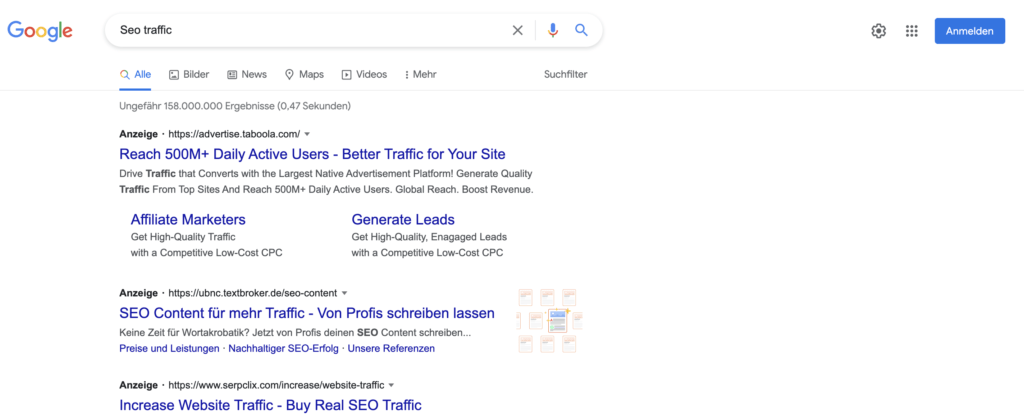
You can use the organic SEOTraffic with tools like Google Analytics und Google Search Console überwachen.
Why is organic traffic so important?
Organic Traffic Comes from your online assets like your social media followers, your email newsletter, and your blog.
As you probably know, it takes time to build up these resources, but over time, the Trafficthat you generate, often much cheaper than paid Traffic.
For example, it takes time to get a blog off the ground, but if you keep at it, the organic Traffic increase exponentially. If your SEOTraffic grows over time, you can make your Reduce budget for paid advertising (or even abolish it altogether!).
It is important to remember that SEO-.Traffic is not free. You either have to create content yourself - in which case you have to factor in the cost of your time - or pay someone to create it for you.
However, you should consider this as Investment because content that ranks well on Google can over the years with minimal additional effort Traffic generate (you should update them regularly though).
How long does it take to build SEO traffic?
Let's take a look at these three different cases and how long it might take in each scenario to get SEO-Traffic build up.
Case 1: Weak website
Stats:
- 0-10 content pages
- 10-50 Backlinks
- None Trust/Authority
Here we are really talking about a newcomer to the web. In the SEO world, this case is comparable to a newcomer who has just left school and is starting out in professional life.
Duration: For such a website it can 6-12 months or even longer to achieve significant Traffic through SEO. This is because Google and other search engines need time to discover, index and rank the website. Ranking to give.
Illustration: Imagine you start as a newbie in a big company. It takes a while for everyone to notice you, let alone give you a promotion!
Case 2: Normal case
Stats:
- 20-40 content pages
- 50-150 Backlinks
- Low Trust/Authority
With this case, we are talking about an average website that already has some content and Backlinks but still gets lost in the crowd.
Duration: Here we are looking at a period of 4-8 monthsto notice a noticeable increase in SEO traffic.
Illustration: Think of a band that has already had a few gigs, but hasn't made the breakthrough yet. They need a few more hits to become really well-known.
Case 3: Strong website
Stats:
- 40-60 content pages
- 300+ Backlinks
- High Trust/Authority
Now we're talking about the big players. This website already has a lot of content, a solid backlink structure and is recognized in the industry.
Duration: For such a website could already 2-3 months are sufficient to optimize the SEOTraffic significantly, provided that the new SEO measures are properly aligned.
Illustration: Think of an already established actor releasing a new movie. It doesn't take long for the movie to get attention because the actor already has a name in the industry.
In conclusion, SEO is a marathon discipline, not a sprint. The above time frames are estimates and may vary depending on the industry, competition and other factors. The most important thing is to consistently do a good job and not give up, even if the results take a while to come.
Advantages of SEO Traffic
SEO Traffic, the Traffic who arrive at a website via search engines has some advantages over other types of search engines. Traffic:
- QualityUsers who arrive at a website via search engines usually have a specific interest in the website and are therefore generally of higher quality Traffic.
- Purchasing powerUsers who arrive at a website via search engines are often willing to spend money because they are actively looking for a solution or a product.
- Pre-qualified: SEO Traffic is usually very targeted, as users search for specific keywords related to the website.
- Long-term: SEO Traffic can be achieved in the long term, as a website that is well optimized usually also achieves good search engine rankings in the long term.
- Cost effectiveness: Compared to other types of online advertising, SEO is Traffic are generally more cost-effective, as there are no direct costs for advertising clicks or impressions.
- Trustworthiness: Users trust the results of search engines and are therefore more likely to click on a web page that is Search Engine is recommended.
Overall, SEO offers Traffic So there are a number of advantages that can help a website be more successful and generate more traffic. Trafficconversions and sales.
SEO traffic compared with other traffic sourcesb
- SEO-Traffic: SEO (search engine optimization) refers to the optimization of a website to rank better in the organic (non-paid) search results of search engines such as Google, Bing or Yahoo. SEO-Traffic is therefore the Trafficthat comes from these organic search results. Since users are mostly looking for specific information, products or services, the SEO-.Traffic is usually targeted and often has a higher conversion rate. However, SEO requires continuous effort and time to achieve and maintain good rankings.
- Traffic through social media: Traffic through social media refers to visitors who come to your website by clicking links on platforms such as Facebook, Twitter, Instagram, or LinkedIn. This Traffic can be organic (through sharing content) or paid (through ads on social platforms). Social media allows you to connect with your audience and build a community around your brand. The Traffic from social media is often less targeted than SEO-Trafficas users do not usually actively search for specific information or products. However, the Traffic from social media grow quickly when content goes viral or you run targeted ads.
- Paid advertisements: Paid advertisements refer to Trafficwhich is achieved through paid advertising space on search engines (e.g. Google Ads), social media (e.g. Facebook Ads) or other platforms (e.g. display networks) is generated. In contrast to organic SEO-Traffic you can achieve immediate visibility by paying for every click on your ad. This allows you to quickly and specifically Traffic to your website. However, the quality of the traffic depends heavily on the Relevance of your ads and the target group selection. Paid ads require a budget and continuous optimization to achieve the best possible results.
SEO traffic vs. paid traffic
Let me break it down for you.
Imagine you have a fruit stand. There are two types of customers who come to your stand:
- Those who are lured by a promoter: This promoter stands at the side of the road, holds up a sign and convinces everyone who passes by to stop by your stand. For every visitor he brings, you pay him something. These are the people who come through paid advertising, i.e. "purchased Traffic", come to you.
- The ones that come naturally: These are people who have heard about your fruit stand from friends, who are there because of your good reviews and quality, or who just happen to walk by and see that your fruit is exactly what they were looking for. These are the people who come to you through SEO.
Why is the SEOTraffic more valuable?
- Intention: People who come to your site through search engines often have a clearer intention. They were looking for something they want or need. So if they land on your stand, they are more likely to buy something. Think of it like this: Someone searching for "fresh apples near me" and coming across your stand is probably ready to buy apples!
- Cost: Once set up, organic SEO costsTraffic less in the long run than constantly paying for ads. You invest in good SEO at the beginning, and it pays off over months or even years. With paid Traffic you pay for every click. It's like giving the promoter money every time someone visits your stand. With SEO, it's like paying once for a good sign and then getting customers again and again.
- Trust: People often trust organic search results more than ads. If your fruit stand is known as the best in the area, people trust that they'll get good quality from you. With ads, they know you've paid to be seen.
- Long-term value: While ads are stopped immediately if you stop paying for them, your SEO efforts will often continue Traffic even if you temporarily stop investing in it. It's as if the reputation of your fruit stand continues to attract customers, even if the promoter is long gone.
In summary: While purchased Traffic definitely has its place and its advantages (for example fast visibility), SEO-Traffic often delivers a higher ROI in the long run, attracts higher quality visitors and builds trust and authority for your brand. It's like the difference between a quick energy boost from a sugar bar and the sustained energy from a balanced meal!
5 ways to increase your SEO traffic
So the question is: how can you increase your organic SEO Traffic erhöhen? Um diese Frage zu beantworten, schauen wir uns 5 Techniken an, die du anwenden kannst.
1. target the right keywords
The Keyword-Research should usually be the first step of your SEO strategy and your entire Content strategy be. The question you asked with the Keyword-The answer to the question you want to answer in your research is:
"What is my target group searching for on Google?
We assume you already know what topics your potential customers are interested in, but knowing exactly what keywords and search queries they use is an important first step to increasing search traffic.
One way to find out what search queries people are using is to type a broad keyword into Google and look at the suggestions. For example, if your target audience is E-commerce-entrepreneurs, you can enter "E-commerce" see other common search terms that people are using:
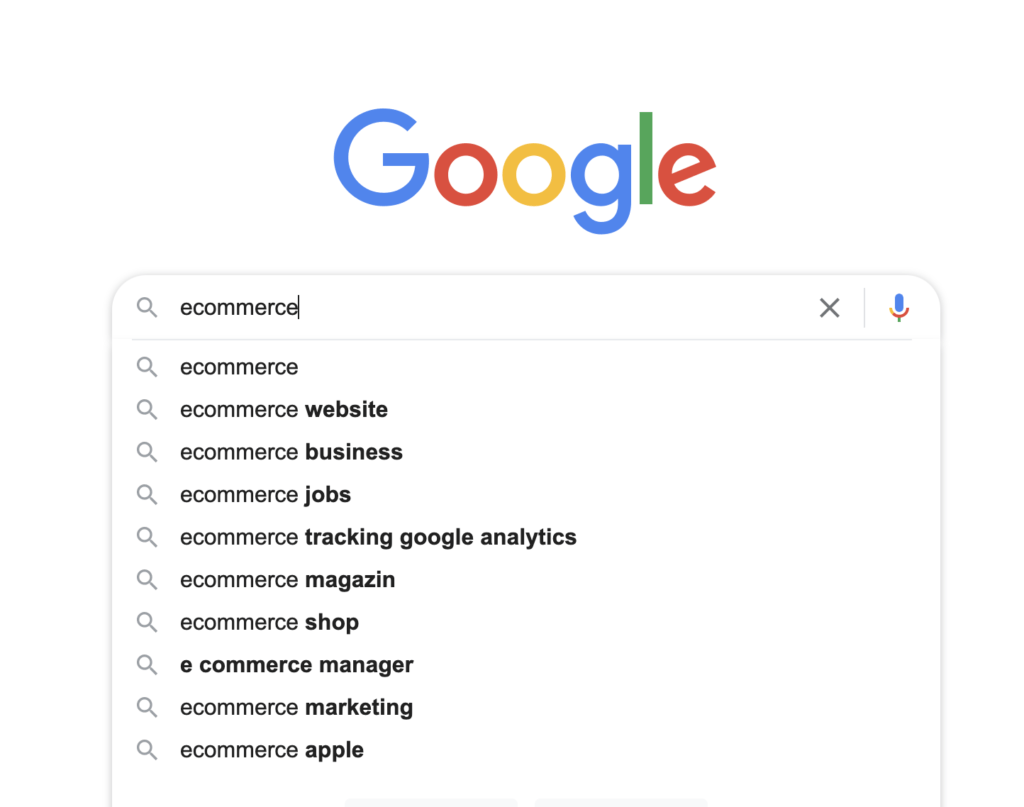
Now is the time to use tools like SEMrush, Ahrefs, Moz Pro or the Google Keyword Planner to find out more about these keywords.
Here are the two most important things you should know:
- Search volume:How many search queries for this Keyword are carried out every month?
- Keyword-Difficulty:How difficult is it to find Keyword on the first page of the GoogleSearch results to stand?
Wenn du gerade erst anfängst, solltest du in der Regel nach Long-Tail-Keywords mit gutem Search volume and low competition.
You may be wondering what a "proper Search volume" depends solely on your niche:
A long-tailKeyword in the fitness niche
(e.g. "best six pack exercises") receives 10,000 to 100,000 search queries per month".
"A long tailKeyword in a B2B area such as digital marketing
(e.g. "best SEO software") is only searched for 100-1,000 times per month.
It may be worthwhile to use the Search volume for your niche so you can get a better understanding of what you should be aiming for.
Once you've built up your own domain authority, you can start competing for keywords with high Search volume endeavor.
To research more precise search volumes I recommend SEO Tools like SEMrush or KWFinder.
Some examples:
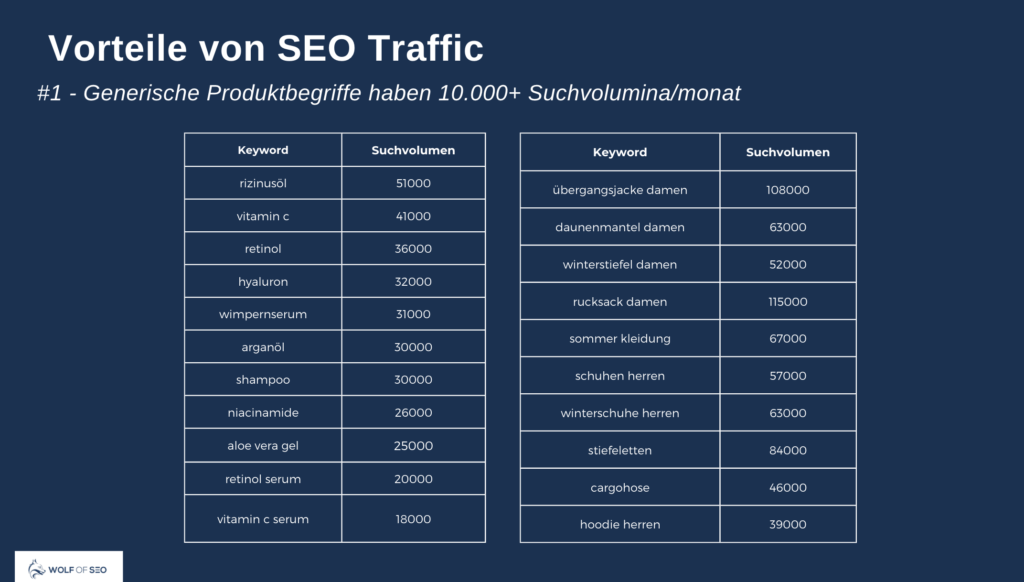
2. create high quality content
Google has gone to great lengths to ensure that the best content appears at the top of search results. This means that Content marketing (which includes SEO) usually only works if you create good content.
Of course, this doesn't always work out, but if you are in the most popular Search Engine the world, it's best to create high-quality content to boost your SEO. Traffic to reach.
But what does "high-quality content" actually mean? To answer this question, you should think about a few things:
Your content matches the search intent
The most important thing to consider is whether your content matches the search intent.
In other words: When someone places a link to your website on the first page of Google'sSearch results and clicks on it, will he find what he was looking for?
There are four types of search intentions:
- Information intent This means that the person is searching for information. For example: "capital of Mozambique", "ketogenic diet", "how to download a YouTube video", etc.
- Transaction intentThe person is researching a potential purchase. For example: "top hostels in London", "best email marketing software", etc.
- Commercial IntentThe person searches for a product they want to buy. For example: "Moleskine notebook", "order pizza Barcelona", etc.
- Navigation intentionThe person wants to go to a specific website. For example, "Sennheiser United Kingdom", "Tropical MBA Podcast", etc.
If you are looking for a Keyword you need to determine and fulfill the search intent, otherwise you will probably have a hard time ranking on Google.
Here is a helpful chart to understand search intentions:
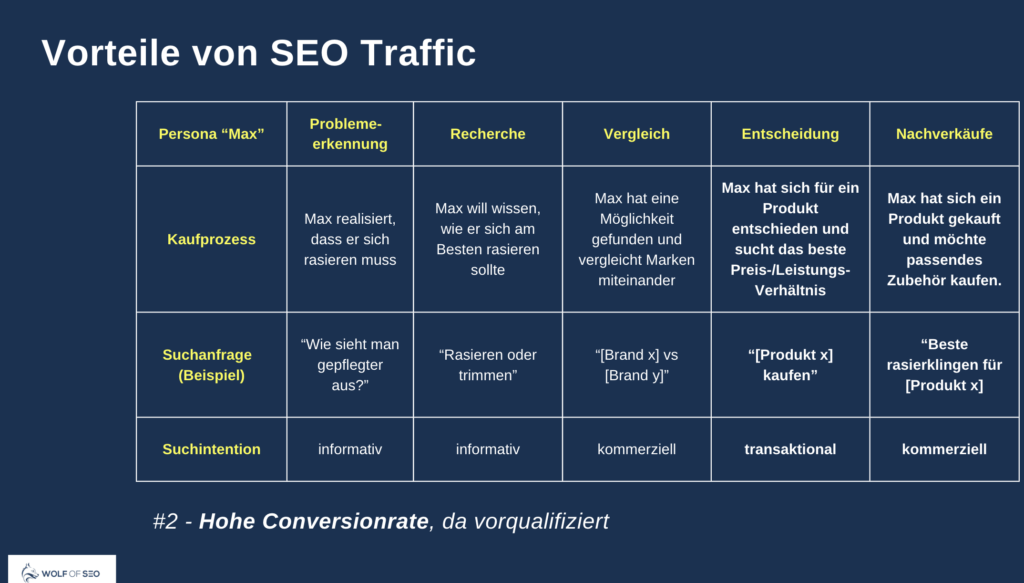
Detailed content wins top positions
You should also try to create the most comprehensive resource on the subject on the Internet.
Once you have determined the search intent, your first priority should be to fulfill it. After that, you need to think about how you can make the content even more helpful than the existing results.
To do this, try to put yourself in the shoes of the person who typed that search term into Google:
- What problems could it encounter?
- What are the most helpful tips and tricks that can make things easier?
- What additional information would you find useful?
It's important that you resist the temptation to simply increase the word count. Remember the search intent and ask yourself: "What does the person typing this search term into Google want to achieve?".
Do it better than the competition
Next, you should focus on making your content better than what's already on the market.
You can do this by analyzing the content that already appears on the first page of the Google search results.Search results and find out how you can improve them.
Here are a few ideas:
- Use the correct formatting:
1-2 line paragraphs, bullet points for lists, images to break up the text, etc.
- Provide more and better information:
Back up your claims with statistics whenever you can. It is best to only use data that is not older than 2 years.
- Add examples from real life:
Tell the story of someone who has already experienced all this. Preferably with figures, screenshots and other relevant examples. Because people love case studies.
- Cite trustworthy sources and statistics:
Try to find relevant scientific papers. However, make sure that you actually read the work you cite in full, otherwise you run the risk of misrepresenting the research.
- Create your own images:
On websites like Upwork, you can easily find a graphic designer to create custom images for your blog at an affordable price.
It is important to know that the competition for the coveted spots on the first page of GoogleSearch results is very tough. That means you have to outperform everyone else if you want to stand a chance.
3. optimize your content to increase SEO traffic
Eine Möglichkeit, deine Inhalte zu optimieren, ist Surfer SEO, ein SEO-Tool, das dir hilft, in den Google-Suchergebnissen besser zu ranken, indem es dir zeigt, wie du deine Inhalte relevanter gestalten kannst und welche Keywords du einbeziehen solltest.
The idea behind this tool is that Relevance the most important Ranking-factor of Google. Put simply, the better your content matches the search intent, the higher it will rank.
Die wertvollste Funktion von Surfer SEO ist die Optimierung von Inhalten auf Relevance. You insert your article and receive a rating from by a Content Score, which is based on word count, keyword optimization, text structure, readability and the Relevance based in comparison with the competition.
Sobald du deinen Score hast, kannst du Ihn verbessern. Du kannst zum Beispiel mehr relevante Begriffe aus der Liste von Surfer SEO einfügen. Arbeite weiter daran, bis du einen möglichst hohen Contentscore hast und deine Keywordoptimierung weitestgehend grün ist. Dies kann deine Chancen auf einen Platz auf der ersten Seite der Google-Search results and thus the SEO Traffic to increase
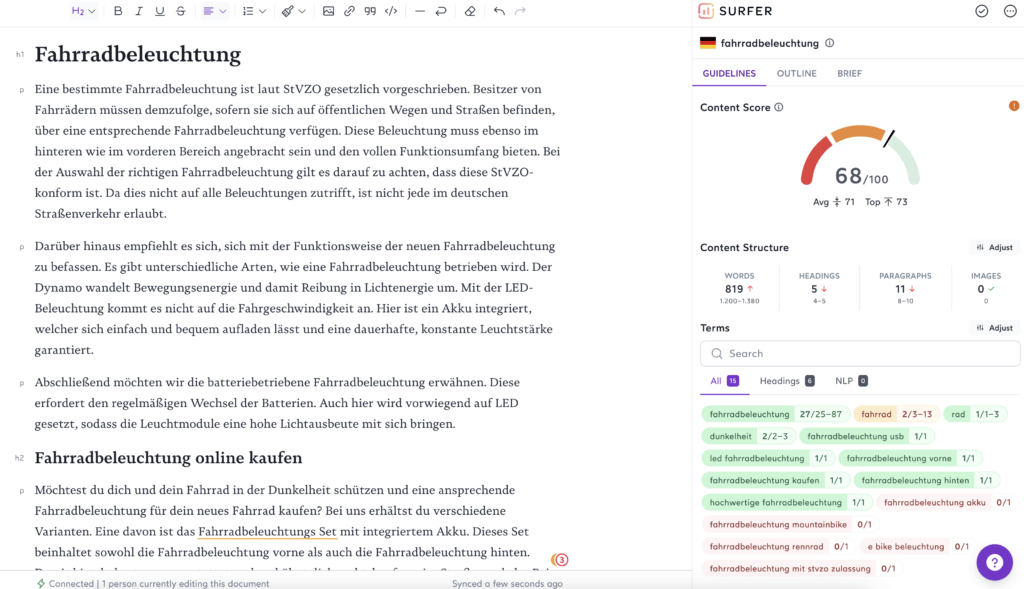
Surfer SEO has a fair pricing, because the entry plan starts at 50€ /month. If you can afford it, it's worth the investment.
4. deal with link building
The second most important GoogleRanking-factor are Backlinks, because people linking to a website show that the website has value. A very effective method to improve the SEO Traffic.
That's why link building is extremely important. You need to put yourself out there and get those links, but how exactly can you do that?
The simplest way, Backlinks to get are Guest contributionswhere you can offer an established website a free Guest article in exchange for a link to your own website. You can expect at least one link in return, but perhaps you can place another link in the post itself.
If you have a Guest article you must of course ensure that the item you are offering is first class.
You should also bear in mind that not all websites are of equal value in the eyes of Google. The higher the domain authority of a website, the more valuable a link from this website is.
That's why you should use the Ahrefs Backlink Checker Tool nutzen, um herauszufinden, ob es sich lohnt, einen Guest article on a particular website, as it may be that they do not have so much SEO Traffic as you might suspect. Alternatively you can also SEMrush or similar
As a rule, you should choose websites that have a domain authority of 20+.
You can also use AgencyAnalytics' backlink monitoring tool to track your link building campaign.
5. pay attention to your on-page SEO
On-page SEO refers to the measures you can take on your website to improve your search ranking.
The most obvious is the use of your target keywords in your post:
- Take your Keyword in the page title.
- Mention your Keyword in the first 100 words.
- Use it several times in the article itself. But don't overdo it, otherwise it will come across as spammy.
- Use it in the Meta description of the contribution.
- Use it in the meta text of the post.
- Use it in the URL of the contribution.
All these measures on the page help Google to better understand what your content is about.
6. do not neglect your PageSpeed
You should also make an effort to improve the loading speed of your site, as Google has pointed out that this is an important ranking factor.
The first step to improve the page speed is the Compression of all images on your website with a tool like TinyJPG.
If you use WordPress, you should switch to a lightweight theme and remove unnecessary plugins or switch to Ghost.
Improving loading speed should also help reduce your bounce rate, which can be another Google ranking factor (although it's not clear if that's really the case).
These are just some of the basics of on-page SEO, but there are many more optimizations you can make. Improving the user experience, using internal links, adding Anchor text to pictures etc.
When can you expect SEO traffic results?
Now you might be wondering how long it takes to see results with SEO?
- Within the first 3 months you should see an increase in impressions in Google Analytics see
- Within the first 6 months you should be on Google Traffic of keywords outside your brand name.
- Within the first 12 months, you should see accelerated growth in organic traffic.
- Within the first 2 years, you should have built up your authority in the eyes of Google and be able to "rank for almost anything". That's when you'll see most of your SEO growth.
You should publish one blog post per week, promote your content on social media every week and build 5-10 links per month if you want the best possible results.
If you do this, you will see results within the first 6 months, but you will see most of your results within the first 12-16 months.
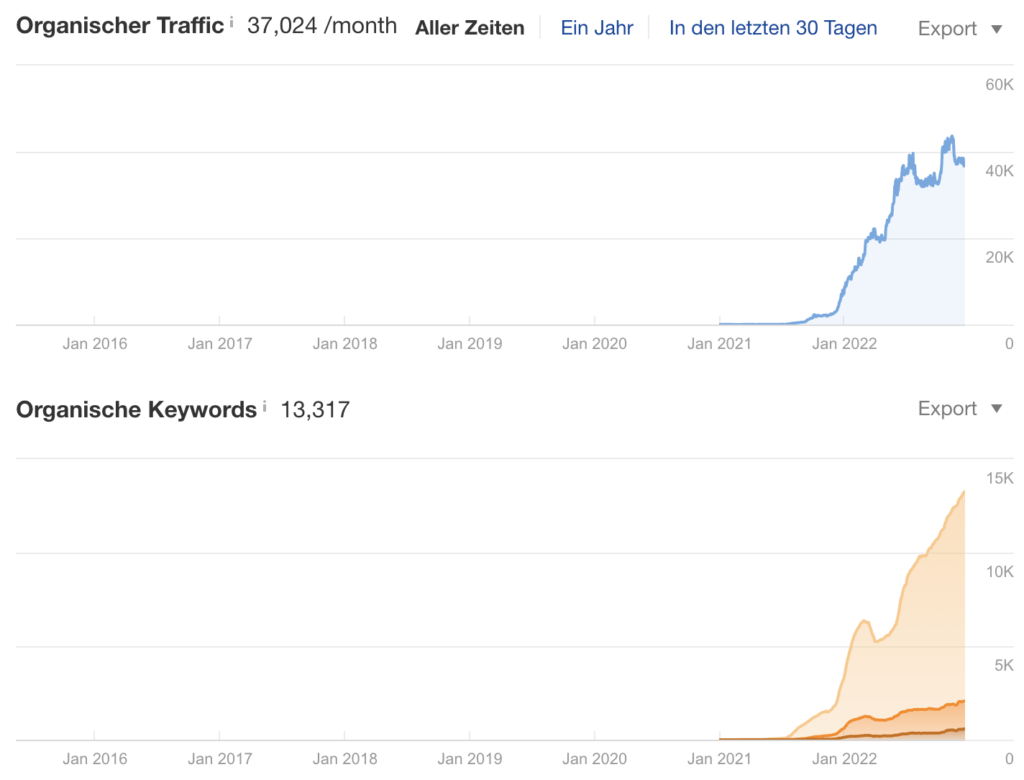
Particularly diligent work on content can also deliver results much faster. Here is the result from our client Dein Sprachcoach.
To achieve this, we published more than 15 articles per month on the blog and regularly placed guest posts on websites with high domain authority.
So if you want to achieve extraordinary results, you have to be prepared to put in an extraordinary amount of work.
SEO Traffic: Conclusion
SEO-Traffic is like the heart of a successful website and contributes significantly to the growth and success of your online presence. Think of SEO as the foundation of a house - once built properly, it provides stability and consistency. Unlike short-lived paid ads that only run for as long as your budget lasts, your SEO efforts last and provide continuous, organic traffic. Traffic. It's as if your house continues to stand solidly, even when the wind blows and the rain falls.
Another important aspect is the high target group relevance of SEO-.Traffic. Imagine your website is a store in a busy shopping street. SEOTraffic is like customers who are specifically looking for your store because they want the exact product or service you offer. This leads to a higher conversion rate, as these users are already actively searching for what you are offering.
SEO is also a cost-effective marketing tool. It's like the snowball rolling down the hill and getting bigger and bigger - with relatively little effort, you can benefit in the long term from free and high-quality marketing. Traffic benefit.
The credibility and trust that a well-optimized website enjoys can be compared to a reputable address. When your website ranks well in organic search results, users perceive it as more trustworthy and credible - much like a store in a reputable high street.
After all, effective SEO gives you a decisive competitive advantage. A well-optimized website is like the lighthouse that shines in a stormy night and attracts more potential customers, while other less visible websites remain in the dark.
Overall, SEO-Traffic The core of a successful online strategy that contributes to sustainable growth and success through long-term visibility, high target group relevance, cost efficiency, credibility and competitive advantages.


